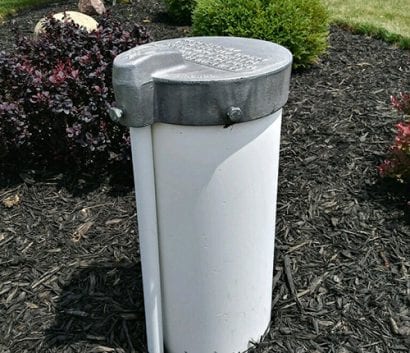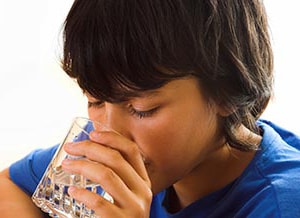Private Drinking Water and Public Health
About 1 in 8 American residents get their drinking water from a private well.[1-3]
- About 1 in 5 sampled private wells were found to be contaminated with at least 1 chemical at levels that could affect health.[4]
- From 1971 through 2008, the proportion of outbreaks associated with private water sources increased.[5,6]
- Fifty-six percent of local health departments regulate, inspect, or license private drinking water in their community.[7]

Private well in an Ohio backyard
Private drinking water sources are not covered by the federal Safe Drinking Water Act, which focuses on public water systems.
Private drinking water sources include
- Private (or household) wells,
- Springs,
- Cisterns,
- Water storage tanks, and
- Trucked water.
Private drinking water sources may not be tested regularly.
Private drinking water is not always treated to remove contaminants. In addition, because private drinking water systems are not covered by the Safe Drinking Water Act,external icon they may not be tested regularly for contaminants. Without regular testing, people may be exposed to contaminants that can affect their health without knowing it or being able to do anything about it.
Contaminants such as germs, chemicals, or radionuclides can contaminate wells and other private drinking water sources.
These contaminants could also affect health.
| Microbiological | Chemical | Radiological |
|---|---|---|
Corrosive groundwater can cause lead to leach from pipes, plumbing fixtures, and solder that contain lead into the public drinking water supply. Lead also poses a threat to private well users. Learn more about corrosive groundwater and what to do when private well owners find lead in their drinking water.
*Note: Fluorides are naturally occurring compounds. Low levels of fluorides can help prevent dental cavities. High levels can cause fluorosis.
Private drinking water can become contaminated in a variety of ways.
Some regions are prone to high levels of certain contaminants in rock or soil that dissolve into water sources. For example, the northeastern part of the United States has high levels of naturally occurring arsenic in rock formations that can leach into the water during the process of drilling and constructing the well. Other times, pathogens from farm animals can infiltrate poorly designed or lined wells and enter groundwater used for drinking. In addition, flooding and other emergencies can introduce contaminants to wells, springs, and other individual water sources.

CDC’s Safe Water program has a unique role in private drinking water.
We fund drinking water programs at health departments to improve access to safe drinking water in private systems in their communities (for example, private wells, springs, cisterns).
Residents in rural communities are more likely to use private wells, and these wells tend to be more prone to having germs or chemicals.
CDC’s Safe Water program strengthens safe water for community health. CDC supports drinking water programs at health departments to improve access to safe drinking water in wells and private systems in their communities.
Drinking water programs in these health departments are working to
- Identify well issues that might present a risk to human health.
- Identify interventions that address the risk.
- Choose and try the best intervention.
- Find out whether the intervention worked.
References and Notes
[1] Dieter CA, Maupin MA, Caldwell RR, Harris MA, Ivahnenko TI, Lovelace JK, et al. Estimated use of water in the United States in 2015.external icon Circular 1441 [Supersedes USGS Open-File Report 2017–1131]. Reston, VA: U.S. Geological Survey; 2018. p. 23.
[2] U.S. Census Bureau. Population estimates, July 1, 2018 (V2018).external icon QuickFacts, United States.
[3] Numerator calculated by multiplying the percentage of self-supplied domestic withdrawals from ground water (98.47%) by the 42.5 million total self-supplied population (Dieter et al. 2018), resulting in an estimated 41.8 million people using private wells. Denominator is the 2018 U.S. population (U.S. Census Bureau).
[4] DeSimone LA, Hamilton PA, Gilliom RJ. Quality of ground water from private domestic wells in principal aquifers of the United States, 1991–2004: overview of major findings.external icon Circular 1332. Reston, VA: U.S. Geologic Survey; 2009.
[5] Craun GF, Brunkard JM, Yoder JS, Roberts VA, Carpenter J, Wade T, et al. Causes of outbreaks associated with drinking water in the United States from 1971 to 2006.external icon Clin Microbiol Rev. 2010;507-28.
[6] Brunkard JM, Ailes A, Roberts VA, Hill V, Hilborn ED, Craun GF, et al. Surveillance for waterborne disease outbreak associated with drinking water–United States, 2007-2008. MMWR Morb Mortal Wkly Rep. 2011;60:38-75.
[7] National Association of County and City Health Officials (NACCHO). 2016 national profile of local health departments. pdf icon[PDF – 2.64 MB]external icon Washington, DC: NACCHO; 2017.